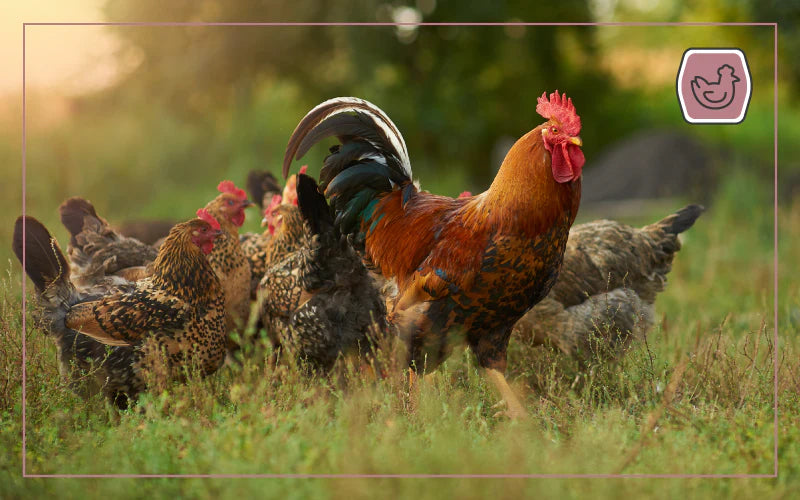
Friendly Flocks: Understanding Chicken Social Dynamics
|
|
Time to read 3 min
 You are being redirected to QC Supply Pharmacy, where you’ll find a wide selection of high-quality prescription and pharmaceutical products for animals of all sizes.
Enjoy the same great service and expertise you trust from QC Supply.
Click below to continue shopping.
Continue
No thanks, stay on the main site
Powered by
You are being redirected to QC Supply Pharmacy, where you’ll find a wide selection of high-quality prescription and pharmaceutical products for animals of all sizes.
Enjoy the same great service and expertise you trust from QC Supply.
Click below to continue shopping.
Continue
No thanks, stay on the main site
Powered by


|
|
Time to read 3 min
There's a lot going on beneath the surface in every chicken coop. Behind those feathers lies a complex web of interactions, communication, and hierarchy rivaling even the most intricate human societies.
From establishing a pecking order to navigating the nuances of flock dynamics, understanding how chickens behave is crucial for keeping harmony in the coop. Let's take a closer look at what makes every cluck tick.
The pecking order is the backbone of every chicken society. It’s a hierarchical structure that dictates dominance and submission within the flock. This order isn't merely about who gets to eat first but extends to all aspects of chicken life, from perching preferences to access to nesting boxes. Each member knows its place, and disputes are settled through subtle cues or, in some cases, a quick peck.
To maintain harmony, provide plenty of space and resources, like food and water, to prevent disputes. If you notice aggressive behavior, such as one chicken constantly picking on others, separating them temporarily or introducing more distractions like hanging treats might be necessary.
Chickens engage in intricate social behaviors, whether free-ranging or spending time in the coop. They form alliances, seek out companionship, and rely on the safety of numbers to navigate their surroundings. Understanding these dynamics can help you keep your chickens happy and plan upcoming changes or expansions better.
One of the main things to remember when it comes to flock dynamics is that, while chickens are highly social, too much crowding can lead to stress and aggression. Ensure your coop has enough space for each bird, with plenty of roosting spots and hiding places to escape conflicts. Introducing new members gradually can also help reduce tension and ensure a smoother integration into the flock.
Chicken communication
You probably already know that chickens are anything but silent. Vocalizations ranging from barely noticeable clucks to warning calls convey a myriad of messages to flock members. Similarly, body language speaks volumes in the chicken world, from the subtle tilt of a head to the puffed-up bravado of a dominant rooster.
Pay attention to their different sounds and movements to understand what they're trying to say. For example, a loud squawk might signal danger, while soft clucking can indicate contentment. By tuning into these cues, you can better respond to their needs and address potential issues.
Mating behavior in domestic chickens
Ah, the regal dance of courtship! Mating behavior among chickens is a sight to behold, with roosters vying for the attention of broody hens. From strutting to serenading their chosen mates, roosters pull out all the stops to win affection. But keep a close eye on those behaviors to ensure the well-being of both hens and roosters.
If you're looking to hatch fertile eggs, provide a comfortable nesting box with clean bedding for comfortable egg laying. Also, watch your roosters' behavior, as excessive mating attempts can stress out hens. Consider separating roosters from hens if you notice signs of distress or over-breeding.
Addressing aggression and bullying in your flock
Chickens are not immune to conflicts. Aggression or bullying can arise within the flock, disrupting harmony and causing distress among members. To help re-establish peace, ask yourself, "Why are my chickens fighting?”
The answer could be anything from overcrowding and competition for resources to individual personalities. The bottom line is that no one will know your chickens better than you, and the more time you spend with the flock, the better you’ll be at nipping potential conflicts in the bud.
Additionally, you must intervene promptly to prevent injuries whenever you notice a fight. Remove the aggressor temporarily to give the victim a chance to recover and regain confidence. Make sure the coop has plenty of space for everyone and has plenty of spots for resting and hiding.
Friendly flocks, happy flocks
Domestic chickens are more than mere egg-layers. They are complex creatures with intricate social structures and behaviors worthy of admiration and study. So, the next time you catch your chickens dust bathing or engaged in a heated discussion over nesting rights, take a moment to appreciate the intricate dance of chicken social dynamics unfolding before your eyes. After all, every cluck, strut, and peck tells a story of connection and community.
By paying attention to how your chickens are acting and reacting to each other as well as the environment, you can help solve social problems while making sure the flock is living their best life. Make sure you give your flock ample space and resources to keep disputes at a minimum and harmony at a maximum. Check out our full selection of Poultry & Gamebird Equipment here.
Do you have some tips we missed? Drop a comment below. Need further assistance? Give our experts a call today at 888-433-5275.

